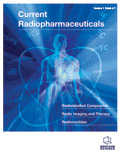
Current Radiopharmaceuticals
Scope & Guideline
Pioneering insights in radiopharmaceutical research.
Introduction
Aims and Scopes
- Radiopharmaceutical Development:
The journal emphasizes the synthesis, characterization, and optimization of radiopharmaceuticals, including novel radiolabeling techniques and formulations for improved diagnostic and therapeutic efficacy. - Radiotherapy and Radiosensitization:
Research on enhancing the effectiveness of radiation therapy through radiosensitizers, exploring mechanisms of action, and evaluating therapeutic outcomes in various cancer types. - Multimodal Imaging Techniques:
A focus on the integration of different imaging modalities (e.g., PET, CT, SPECT) to enhance diagnostic accuracy and treatment monitoring, including the development of new imaging agents. - Theranostics and Personalized Medicine:
The journal explores theranostic approaches that combine diagnostics and therapeutics, highlighting the potential for personalized treatment strategies in oncology and other diseases. - Radiobiology and Safety:
Research on the biological effects of radiation, including protective measures against radiation-induced damage and the assessment of radiation safety in clinical practices.
Trending and Emerging
- Nanotechnology in Radiopharmaceuticals:
The integration of nanotechnology into radiopharmaceutical development is gaining traction, with studies focusing on nanoparticle-based delivery systems and their therapeutic applications in oncology. - Targeted Radiotherapy Approaches:
Emerging research on targeted radiotherapy, including the use of specific ligands for selective delivery of radiopharmaceuticals to tumor cells, is becoming increasingly prominent. - Innovative Imaging Techniques:
There is a growing interest in developing and validating advanced imaging techniques, such as hybrid imaging modalities and novel radiotracers, to improve diagnostic accuracy and treatment planning. - Radioprotective Agents and Strategies:
Research into agents that can protect healthy tissues from radiation damage is on the rise, highlighting the importance of improving patient safety during radiation therapies. - Clinical Applications of Artificial Intelligence:
The application of AI and machine learning in optimizing radiopharmaceutical production, imaging analysis, and treatment planning is emerging as a significant trend, indicating a shift towards technology-driven solutions.
Declining or Waning
- Traditional Radiopharmaceuticals:
There is a noticeable decline in research related to conventional radiopharmaceuticals that do not incorporate novel elements or advanced methodologies, suggesting a shift toward more innovative approaches. - General Reviews without New Data:
The number of purely review articles summarizing existing knowledge without presenting new data or insights seems to be decreasing, indicating a preference for original research findings. - Basic Radiobiological Studies:
Research focusing solely on fundamental radiobiological mechanisms without direct clinical or translational applications appears to be less frequently published, reflecting a trend towards practical applications in clinical settings.
Similar Journals
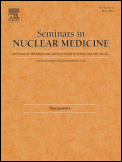
SEMINARS IN NUCLEAR MEDICINE
Advancing knowledge in nuclear medicine.Welcome to Seminars in Nuclear Medicine, a prestigious journal published by W B Saunders Co-Elsevier Inc that has been at the forefront of the field since its inception in 1971. This journal serves as a dedicated forum for researchers, healthcare professionals, and students specializing in the rapidly evolving areas of radiology and nuclear medicine. With an impressive ranking of #29 out of 333 in the Scopus category, drawing an esteemed 91st percentile, it holds a distinguished Q1 category status, highlighting its critical role in disseminating high-quality research and clinical practices. Although it does not operate as an Open Access publication, Seminars in Nuclear Medicine remains a vital resource, featuring comprehensive reviews and insightful articles that inform the medical community about the latest advancements and applications within nuclear imaging. This journal not only enhances knowledge but also encourages collaboration among professionals dedicated to improving patient outcomes through innovative nuclear medicine techniques.

EJNMMI Radiopharmacy and Chemistry
Advancing the frontiers of radiopharmacy and nuclear medicine.EJNMMI Radiopharmacy and Chemistry, published by SpringerNature, stands at the forefront of research in the critical fields of radiopharmacy and nuclear medicine. With an impressive impact factor and a dedicated Open Access policy since 2016, this journal invites the global scientific community to share advancements in the synthesis, development, and application of radiopharmaceuticals within the realm of analytical chemistry and pharmacology. As evidenced by its notable categorizations, including Q1 in Analytical Chemistry and Radiology, Nuclear Medicine and Imaging, along with high Scopus rankings, EJNMMI offers a prestigious platform for rigorous peer-reviewed research that informs and inspires progress in medical imaging and therapeutics. The journal's commitment to accessibility fosters collaboration and innovation, making it an essential resource for researchers, medical professionals, and students seeking to advance their understanding and application of radiopharmaceuticals.

ANNALS OF NUCLEAR MEDICINE
Unveiling the Science of Imaging and TreatmentANNALS OF NUCLEAR MEDICINE is a prominent academic journal dedicated to the field of nuclear medicine, published by Springer. With a rich publication history dating back to 1987 and continuing through 2024, this journal serves as a vital resource for researchers and practitioners interested in the latest developments in nuclear imaging, radiopharmaceuticals, and therapeutic applications. Ranked in the second quartile (Q2) for both Medicine (miscellaneous) and Radiology, Nuclear Medicine, and Imaging categories in 2023, it maintains a strong position in the academic community, with an impressive Scopus rank of #104 out of 333 in its field, placing it in the 68th percentile. The journal is not open access but offers a range of access options through institutional or individual subscriptions, ensuring that critical research findings reach a wide audience. By fostering high-quality, peer-reviewed articles, ANNALS OF NUCLEAR MEDICINE plays a crucial role in advancing the understanding and practical application of nuclear medicine techniques, making it an essential journal for professionals and students aiming to stay at the forefront of this evolving discipline.
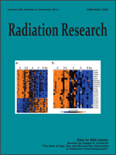
RADIATION RESEARCH
Exploring the complexities of radiation exposure and its effects.RADIATION RESEARCH is a prestigious journal published by the RADIATION RESEARCH SOC that serves as a vital resource for professionals and researchers in the fields of biophysics, radiation science, and radiology. Established in 1954, this journal has consistently advanced the study of radiation's effects on health and the environment, bridging fundamental and applied research. It boasts an impressive impact factor reflected in its quartile rankings, including Q2 in Biophysics and Q1 in Radiation, making it a highly regarded publication within its discipline. Researchers will find valuable insights through rigorous peer-reviewed articles that explore innovative methodologies and findings related to radiation exposure, imaging technologies, and the biological consequences of radiation. Although the journal does not currently offer open access, it remains a vital reference for academia and industry, fostering a deeper understanding of radiation sciences and their implications for future research and public health.

EUROPEAN JOURNAL OF RADIOLOGY
Advancing Imaging Excellence in HealthcareThe European Journal of Radiology, published by Elsevier Ireland Ltd, is a premier peer-reviewed journal in the fields of radiology, nuclear medicine, and imaging. Established in 1981, it has carved a significant niche within the academic community, showcasing innovative research that enhances medical imaging practices and improves patient care. With an impressive ranking in the Q1 category for both Medicine (miscellaneous) and Radiology, Nuclear Medicine, and Imaging in 2023, the journal is recognized globally for its commitment to advancing scientific knowledge and improving imaging methodologies. The journal's Scopus ranking of #60/333, placing it in the 82nd percentile, underlines its reputation for high-quality research and scholarly contributions. While traditionally a subscription-based journal, it continually evolves to meet the demands of the academic landscape, aiming to bridge the gap between research and clinical practice. Researchers, healthcare professionals, and students alike can benefit from exploring its extensive archives and current publications, which are curated to foster education and innovation in the medical imaging domain.
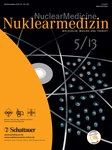
NUKLEARMEDIZIN-NUCLEAR MEDICINE
Pioneering Insights in Imaging and Radiology.NUKLEARMEDIZIN-NUCLEAR MEDICINE is a prestigious journal published by Georg Thieme Verlag KG, focusing on pivotal advancements in the fields of Nuclear Medicine, Radiology, and Imaging. Established in 1959, this journal has served as a critical platform for disseminating innovative research, reviews, and clinical guidelines until its anticipated convergence in 2024. With an ISSN of 0029-5566 and an E-ISSN of 2567-6407, NUKLEARMEDIZIN is acknowledged in the academic community as a Q3 category journal within Medicine (miscellaneous) and Radiology, Nuclear Medicine, and Imaging as of 2023, highlighting its ongoing contribution to the interdisciplinary dialogue in healthcare. Although the journal does not currently offer open access, it remains accessible to professionals and students through various academic databases, ensuring that cutting-edge knowledge in this growing field is shared widely. Researchers interested in the latest methods and technologies in Nuclear Medicine will find NUKLEARMEDIZIN a valuable resource for enhancing their work and understanding the complexities of modern imaging modalities.
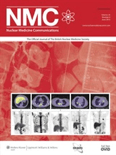
NUCLEAR MEDICINE COMMUNICATIONS
Advancing the Future of Nuclear MedicineNUCLEAR MEDICINE COMMUNICATIONS is a prestigious academic journal published by Lippincott Williams & Wilkins, focusing on the multifaceted field of nuclear medicine and its applications in diagnostics and therapy. With a solid history spanning from 1980 to 2024, this journal provides a platform for peer-reviewed research articles, clinical studies, and innovative techniques that enrich the knowledge base within the fields of {{medicinal applications, patient care, and imaging technology}}. Currently classified in the Q3 quartile for both Medicine (Miscellaneous) and Radiology, Nuclear Medicine, and Imaging, the journal reflects its commitment to advancing healthcare practices. Although it does not offer open access options, its accessibility through reputable institutions promotes scholarly exchange among researchers, professionals, and students alike. The critical insights provided in NUCLEAR MEDICINE COMMUNICATIONS are essential for those dedicated to enhancing patient outcomes through cutting-edge nuclear medical technologies.
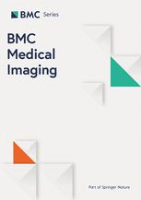
BMC MEDICAL IMAGING
Empowering Researchers and Clinicians in Medical Imaging.BMC Medical Imaging is a premier open-access journal dedicated to advancing the field of radiology, nuclear medicine, and imaging technologies. Published by BMC in the United Kingdom, this journal serves as a vital resource for researchers, clinicians, and students, fostering a collaborative environment for sharing innovative findings and methodologies in medical imaging. With a commendable impact factor and an impressive Scopus ranking within the top 35% of its category, BMC Medical Imaging provides a platform for high-quality research to be disseminated widely and freely since its inception in 2001. The journal aims to cover a diverse array of topics, from advanced imaging techniques to their clinical applications, enhancing the understanding and effectiveness of diagnostic practices. By contributing to the body of knowledge and facilitating open access to research, BMC Medical Imaging plays a pivotal role in shaping the future of medical imaging and improving patient care.

Radiology-Imaging Cancer
Enhancing Cancer Treatment through Radiological Innovations.Radiology-Imaging Cancer is a prestigious journal published by the Radiological Society of North America (RSNA), focusing on the critical intersection of radiology, oncology, and advanced imaging techniques. This journal stands out in its field with a commendable ranking in the Q2 category for Medicine (miscellaneous) and Oncology, and an impressive Q1 ranking in Radiology, Nuclear Medicine and Imaging, according to the 2023 quartiles. With an ISSN of 2638-616X, it serves as an essential platform for the dissemination of research that contributes to the understanding and improvement of cancer diagnosis and treatment. Its comprehensive scope encompasses a range of topics, from innovative imaging modalities to clinical applications in oncology, making it a valuable resource for researchers, clinicians, and students interested in the evolving field of cancer imaging. Despite being published in the United States, the journal aims for a global reach, catering to a wide audience dedicated to advancing medical science.
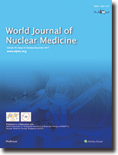
World Journal of Nuclear Medicine
Bridging Research and Practice in Nuclear MedicineWorld Journal of Nuclear Medicine, published by THIEME MEDICAL PUBL INC, is a premier peer-reviewed journal dedicated to advancing the field of nuclear medicine. With an Open Access model established since 2011, this journal ensures that high-quality research is accessible to a wide audience, fostering knowledge sharing and collaboration among researchers, clinicians, and students alike. The journal aims to publish innovative studies, reviews, and clinical trials that contribute significantly to both the theoretical and practical aspects of nuclear medicine, enhancing diagnostic and therapeutic techniques within this critical area of healthcare. As the journal continues to grow in visibility and impact, it remains an essential resource for those seeking to stay at the forefront of advancements in nuclear medicine.